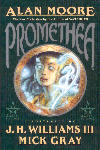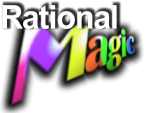

| Promethea. Collected Edition, Book 1. Written by Alan Moore. Pencilled by J. H. Williams III. Inked by Mick Gray. Additional art by Charles Vess. La Jolla, CA: America's Best Comics, 2000. 1v. (unpaged). $24.95hc. ISBN 1-56389-655-9. |

|
GENRES: AUDIENCE: SYNOPSIS: Sophie-Promethea takes Barbara to the hospital--Barbara tries to warn her about all the stuff that's gunning for Promethea, but is too weak--and, remembering her original self, calls her friend Stacia out of a rock concert to help her return to normal. Meanwhile, the Temple sends two bad guys (actually demons) with considerable power to deal with the "walk-in" and her host. The rock concert becomes a battleground as Sophie-Promethea does battle with them and defeats them. However, the two demons escape into the Immateria via a gate, and Stacia is sucked in along with them. Sophie-Promethea consults Barbara for help in getting to the Immateria, a.k.a. the Misty Magic Land; it's a matter of imagining yourself there. In that shifting place, Sophie-Promethea gets help from a tough-as-nails version of Little Red Riding Hood and battles a Wolf as she rescues her friend. To escape the Wolf they have to imagine their way back to New York. Afterwards, Stacia helps Sophie return to normal herself. In the hospital, Barbara is rejecting the "clone-meat" implants and is dying. She projects her spirit into the place where the previous Prometheas dwell. The little group watches Sophie's progress, including when she goes to the library to do more research on Promethea. While there, she meets a nasty old wizard named Jack Faust, who's mostly just playing with her and filling her head with too much knowledge. Only Stacia's arrival disrupts Jack Faust's plans. One thing Jack told Sophie was that Barbara would die in three days, and that looks like the truth. Sophie visits Barbara, who insists that Sophie immediately return to the Immateria and learn to deal with it, because there are far more nasty things waiting for her out there. The rest of the book deals with her experiences there and her encounters with two more of the Promethea hosts: Margaret, whose defining characteristic is compassion, and Grace, who was a pulp-fiction warrior-queen and who embodies rational thought. EVALUATION: As for the overall story, I can't help but think that Moore is treading ground already trod by Neil Gaiman and The Sandman; the book has much of that classic series' feel, especially when Sophie is in the Immateria. The book also reminds me of The Books of Magic, where a gang of elders initiates a young boy in the hidden world of magic, and the boy seems to be merely along for the ride. (Although it must be said that while Tim from The Books of Magic pretty much stood around and let things happen to him, Sophie is a little more proactive than that.) And although I like the world, I wondered why it was necessary to set this story in this kind of quasi-superhero alternate Earth. I think the concept of an avatar of imagination would have been more powerful set against a less fanciful world. As it stands, Promethea is just another piece of "commonplace" exotica when she should stand out in sharp contrast not only to the world at large but also to the creatures she faces. Also, because of the general "magic" of the world, the appearance of said creatures seems more commonplace than it should. In this world these creatures would be a direct affront to the science-based beliefs of the general populace, but because we readers are accustomed to superhero worlds in which anything is possible, they seem like a normal part of the place. Maybe it's because the "science" of this world is, indeed, too much like magic. (It doesn't help that one of the Five Swell Guys is a psychic. That ain't science.) Finally, because of all the explaining and training and back story that's being filled in, the story moves rather slowly. The full-color art is lush and rich but more superhero-ish than I would have preferred for this story; indeed, the art contributes to the unwanted superhero feel of the world. I hate to keep bringing up Sandman, but I always liked the way the art in that series changed when the motif changed (e.g., when the story dealt with Japanese characters), and I was looking for some of that in the sections about the Immateria. But the artists missed a terrific opportunity to go pulp-magazine-cover-happy in the Hy Brasil sequence. Indeed, it's telling that when the villain is defeated, Sophie mentions that "everything looks different," but it doesn't from our point of view; another great opportunity lost, and an example of several instances in the book when the artists made poor decisions about what to depict.
Overall, I found this a pleasant but derivative and uncompelling work. Alan Moore has been much better elsewhere, and has had more useful artists. My guess is that Promethea will be popular with the Sandman crowd. It's not altogether kid-level stuff, but compared to what they can see in the movies and even in standard superhero comics, it's pretty tame. The demons, magic, and semi-naked women might dismay the usual crowd, but there's very little swearing and gore is almost absent. I think the book would go over the heads of most kids, though. Anyway, recommended for the abovementioned Sandman crowd and for Alan Moore fans. |
||||||
Return to Rational Magic Home
